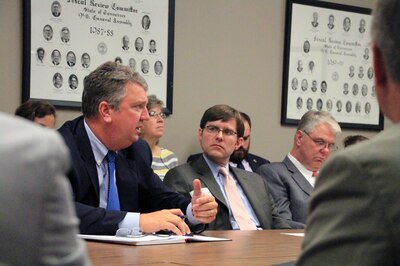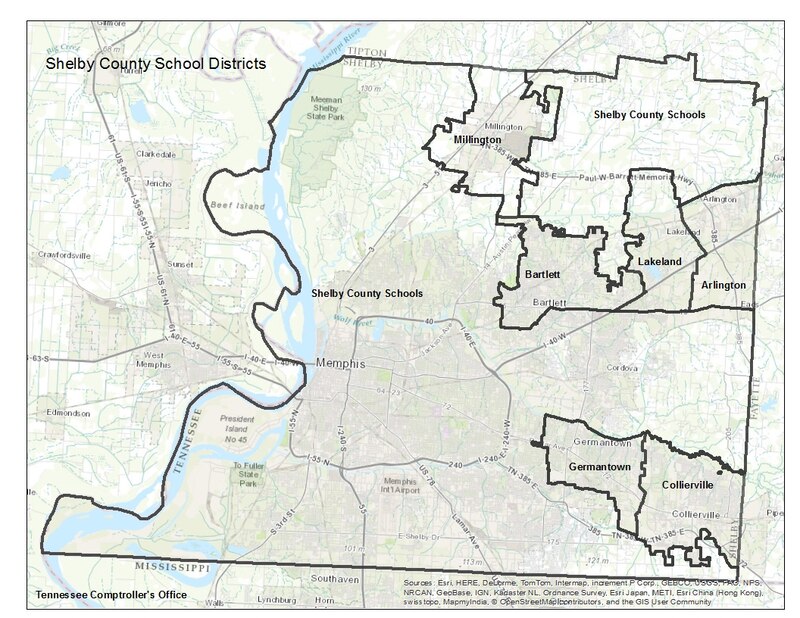Five of six municipal school districts in suburban Shelby County welcomed mostly positive results from their first year of operation based on district-level test scores released by the state on Wednesday, with Millington Municipal Schools as the outlier.
School systems in Arlington, Collierville, Germantown and Lakeland made at least minimal gains in most of the 10 test subjects across grades 3-12, with scores of proficient and advanced hovering in the 70-90 percent range.
Bartlett City Schools scored gains in all subjects, though more of its students consistently scored basic or below compared with its suburban counterparts.
Millington Municipal Schools, the most cash-strapped of the six districts, saw heavy declines in Algebra I scores, with a 17 percent drop and 44.6 percent of its students basic or below. Millington’s 3-8 reading and language arts scores also dropped 7.6 percent — the most of all the municipalities.
By comparison, the 2-year-old Shelby County Schools saw at least minimal gains in nine of 10 subjects and also dropped by 1.1. percent in middle school and elementary reading, mirroring a statewide drop. About 67 percent of Shelby County Schools students are basic or below in reading, and the sunken literacy rates have garnered increased scrutiny from its administrators.
The municipalities, each previously a part of the legacy Shelby County district, began efforts to split off and create their own districts after Memphis City Schools surrendered its charter in 2011, beginning a merger with legacy Shelby County that took effect in 2013. (See Chalkbeat’s in-depth coverage of the merger, the municipalities split and the breakdown of the municipalities by the numbers).
Shelby County Schools initially filed a lawsuit alleging that creation of the smaller municipal districts was racially motivated because their student populations were more white and generally more affluent than that of the former Memphis City Schools.
The municipalities’ first year of scores — which show increases or decreases based on previous school-by-school results — sets the academic benchmark for the new suburban school systems ringing Memphis and solidifies the county’s splintered educational landscape going forward. It also means that the smaller systems may continue to siphon off students from Shelby County Schools, the state’s largest public school district, battered by enrollment and funding declines due in part to the suburban districts’ break-off and the growth of Memphis’ charter school sector under the state-run Achievement School District.
Earlier this month in Nashville, the six superintendents overseeing Shelby County’s municipal districts gave state legislators an update on their first year of operation and, while some highlighted funding dilemmas, all were quick to tout their test scores, which the state had not yet released to the public.
Millington Municipal Schools Director David Roper, who did not immediately return phone calls from Chalkbeat on Wednesday, said at the time he was pleased.
“Considering the high amount of staff and teacher turnover, I believe we did well,” Roper said at the Nashville meeting, referring to the replacement of four principals and a teacher turnover of 50 percent in the system’s middle and high schools. “It’s going to take time until our staff is on stable footing.”
On Wednesday, some of the largest gains included a 15.2 percent jump for Arlington and a 15.9 percent increase for Bartlett in Algebra I, while the largest decline was a 1.5 percent drop in Germantown for students who met expectations in English III.
Besides Millington, Collierville was the only municipal districts to see a drop — of 1.1 percent — in reading scores. Millington has 57 students at basic or below in reading, compared to 24.9 percent in Collierville.

Gap data, which illustrates gains or losses of historically underperforming subgroups against comparison groups, also was released Wednesday. Most of the municipalities saw slight to moderate gains in closing their academic gaps. However, the gap for Millington students with disabilities increased by 27 percent in reading and language arts and widened by 17 percent in Arlington.
In the Lakeland School System, the smallest municipal district with only one elementary school, economically disadvantaged students closed the academic gap by 8.4 percent, while black, Hispanic and Native American students closed the gap by 11.7 percent. Its gap for students with disabilities decreased by 11.9 percent in math and increased by 3.5 percent in reading.
“We are extremely proud of our teachers and students, but we are even more pleased by the gap closures,” Lakeland Superintendent Ted Horrell said. “We’ve put a lot of emphasis in making sure we’re not just addressing the high end but are giving every student the opportunity to be successful.”


